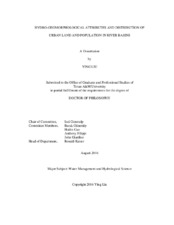| dc.description.abstract | Global urbanization is a major trend in the 21st century and imposes a significant impact on the hydrologic cycle, climate, and biodiversity. In particular, Asia and Africa are expected to experience the fastest urbanization rate in the following decade, manifested by impervious land cover construction and urban population growth. Therefore, accurate information on spatial distribution of urban land and population at the present stage can attribute to a better understanding of urbanization processes in the future. Meanwhile, the knowledge of hydrological responses on the land use and land cover (LULC) change can provide valuable insights into sustainable development strategies.
This dissertation aims to answer three fundamental questions: (1) How do natural environmental factors that relate to water resource, climate, and geomorphological attributes constrain the distribution of current urban land and population? (2) How will the global urban growth in the near future affect the urban exposure to natural disasters such as fluvial flood, drought, and ecosystem degradation? (3) How will land change impact hydrologic processes within a river basin?
To solve the research questions, studies presented in this dissertation are organized into three parts. Part one analyzes the spatial distribution of urban ratio, population density, and urban population density in 11 river basins in Asia and Africa, considering average annual precipitation, surface freshwater availability, and access to coastal zone as three influencing factors. Then, a set of regression models is conducted for the Yangtze River Basin as a more comprehensive investigation. Part two examines the global and regional patterns of urban growth from 2000 to 2030 as well as the change of urban area’s exposure to floods and droughts. Part three is an assessment of streamflow in the Chao Phraya Basin based on different precipitation and LULC scenarios. The Soil and Water Assessment Tool (SWAT) is used to develop the hydrological model.
The results reveal that higher urban ratio and human concentration occur in the vicinity of a stream network and a coastal zone; while precipitation does not effectively influence the distribution of urban land and population as expected. The emerging coastal metropolitan regions in Africa and Asia will be larger than those in the developed countries and will have larger areas exposed to flood and drought. The case study of Chao Phraya River Basin demonstrates that land change will increase both the risk of drought and flood hazards. | en |


